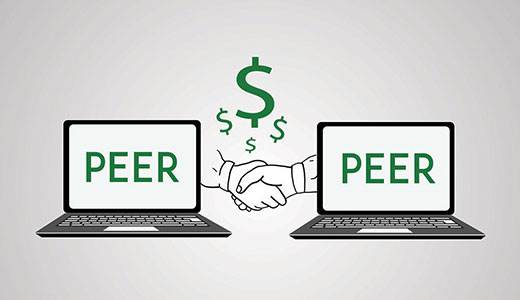
Peer-to-peer lending, also abbreviated as P2P lending, is the practice of lending money to individuals or businesses through online services that match lenders with borrowers without the intermediation of traditional financial institutions (Banks / NBFCs). The development of advanced financial technologies, or fintech, by integrating banking processes with information technology has enabled the creation of financial products and services that can be delivered to consumers at scale, and at a fraction of the cost incurred by conventional banks and NBFCs.
Since P2P lending companies operate online, they can run with lower overheads and provide the service more cost-efficiently than traditional financial institutions. Thereby creating a win-win ecosystem, where lenders can earn higher returns compared to savings and investment products offered by banks, while borrowers can borrow money at lower interest rates.

P2P is an RBI regulated entity registered as Peer to Peer Lending platform that uses new-age technology to match prime borrowers and lenders and in the process eliminates the high intermediation cost plus margins charged by traditional banks and NBFCs, thus, making borrowing cheaper and investing/lending a more lucrative opportunity as compared to traditional investment avenues.
The investment opportunity in P2P is similar to a debt mutual fund where your investment is diversified across multiple borrowers and managed by experts. The exposure is towards small-ticket retail consumer loans which are generally considered safer than corporate debt. On account of lower cost & elimination of middlemen, the returns can be up to 1.5x-2x of liquid debt mutual funds. P2P is set apart from other P2P players as it focuses on only selected segments, education, healthcare & home improvement, which have very strong end-use cases and limited chances of default.


Risk Factors – Investments in Mutual Funds are subject to Market Risks. Read all scheme related documents carefully before investing. Mutual Fund Schemes do not assure or guarantee any returns. Past performances of any Mutual Fund Scheme may or may not be sustained in future. There is no guarantee that the investment objective of any suggested scheme shall be achieved. All existing and prospective investors are advised to check and evaluate the Exit loads and other cost structure (TER) applicable at the time of making the investment before finalizing on any investment decision for Mutual Funds schemes. We deal in Regular Plans only for Mutual Fund Schemes and earn a Trailing Commission on client investments. Disclosure For Commission earnings is made to clients at the time of investments.
AMFI Registered Mutual Fund Distributor – ARN-128554 | Date of initial registration ARN – 04-Sep-2017 | Current validity of ARN – 25-Aug-2026
Grievance Officer- Kaushal Dave | ksd.abd@gmail.com
Important Links | Disclaimer | Disclosure | Privacy Policy | SID/SAI/KIM | Code of Conduct | SEBI Circulars | AMFI Risk Factors